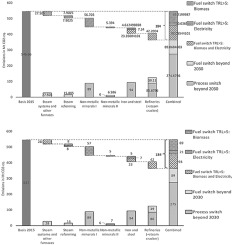Renewable and Sustainable Energy Reviews ( IF 15.9 ) Pub Date : 2019-12-23 , DOI: 10.1016/j.rser.2019.109672 M. Rehfeldt , E. Worrell , W. Eichhammer , T. Fleiter

|
In 2015, industrial sector installations included in the European emission trading system (EU ETS) emitted 574 Mt CO2-equivalent Greenhouse gas (GHG) emissions. Among them are production of clinker, lime and ammonia, blast furnace operations, refineries and others. The emission intensity of these installations is closely tied to the fuel type used. Global warming scenarios of 1.5 °C recently presented by the IPCC require fast emission reduction in all sectors until 2030, followed by deep reductions, reaching carbon neutrality around 2050. In this paper, the technical potential to use biomass and electricity with existing or available technologies in important industrial processes is reviewed. The investigated industries account for 95% of the total verified emissions in the EU ETS industrial sector 2015 and 64% of total industrial emissions of the EU28. We find that 34% (184 Mt) of these emissions could be avoided from a technical perspective until 2030 with fuel switch measures towards biomass and electricity. This reduction is in line with 1.5 °C global warming scenarios until 2030, but further effort is required beyond that. We also find that available options lack economic competitiveness under present conditions, e.g. due to high electricity prices. We conclude that, although considerable fast emission saving potential by switching to biomass and electricity are possible, deep decarbonisation in line with climate targets requires innovative production processes only available in the long term.
中文翻译:

到2030年欧洲基础材料行业燃料转向生物质和电力的燃料减排潜力的回顾
2015年,欧洲排放权交易系统(EU ETS)中包括的工业部门设施排放了574 Mt CO 2-等效的温室气体(GHG)排放量。其中包括熟料,石灰和氨的生产,高炉操作,精炼厂等。这些设施的排放强度与所使用的燃料类型紧密相关。IPCC最近提出的全球升温1.5°C的情景要求在2030年前在所有部门中快速减少排放,然后进行大幅度减少,到2050年左右达到碳中和。在本文中,利用现有或现有技术来利用生物质和电力的技术潜力在重要的工业过程中进行了审查。被调查行业占欧盟排放交易体系工业部门2015年核实排放总量的95%,占欧盟28国工业排放总量的64%。我们发现,从技术角度来看,到2030年,采用燃料转向生物质和电力的措施可以避免这些排放的34%(184 Mt)。到2030年,这一降低幅度符合1.5°C的全球变暖情景,但除此之外,还需要进一步的努力。我们还发现,在当前情况下,例如由于电价高昂,可用的选件缺乏经济竞争力。我们得出的结论是,尽管通过转换为生物质和电力可以实现巨大的快速节能减排潜力,但要实现符合气候目标的深度脱碳,就需要长期使用创新的生产工艺。我们还发现,在当前情况下,例如由于电价高昂,可用的选件缺乏经济竞争力。我们得出的结论是,尽管通过转换为生物质和电力可以实现相当大的快速减排潜力,但要实现符合气候目标的深度脱碳,就需要长期有效的创新生产工艺。我们还发现,在当前条件下,例如由于电价高昂,可用的选择缺乏经济竞争力。我们得出的结论是,尽管通过转换为生物质和电力可以实现巨大的快速节能减排潜力,但要实现符合气候目标的深度脱碳,就需要长期使用创新的生产工艺。


























 京公网安备 11010802027423号
京公网安备 11010802027423号